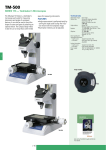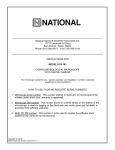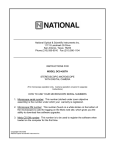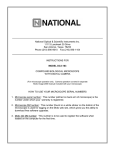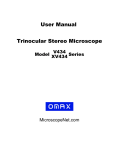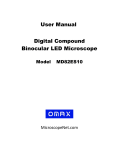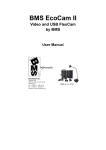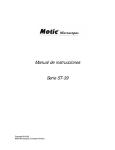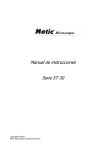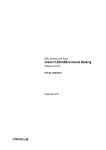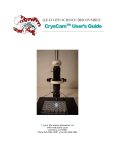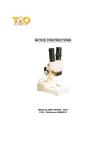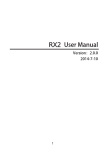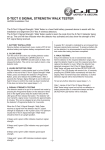Download National Optical & Scientific Instruments Inc
Transcript
National Optical & Scientific Instruments Inc. 11113 Landmark 35 Drive San Antonio, Texas 78233 Phone (210) 590-9010 Fax (210) 590-1104 INSTRUCTIONS FOR MODEL DC3-420TH STEREOSCOPIC ZOOM MICROSCOPE WITH DIGITAL CAMERA (For microscope operation only. Camera operation covered in separate Motic Image 2000 manual included with your microscope) HOW TO USE YOUR MICROSCOPE SERIAL NUMBERS 1. Microscope serial number: This number (etched on the post base) is the number under which your warranty is registered. 2. Microscope DM number: This number (found on a white sticker on the bottom of the microscope) is used for logging on the Motic web site, which gives you the ability to download free software upgrades. 3. Motic CD DM number: This number is to be used to register the software when loaded on the computer for the first time. Copyright © 1/2/01 National Optical & Scientific Instrument Inc. About the Digital Microscope The manual for your new digital microscope is in two parts. This first part describes the basic nomenclature and functions of the microscope, which can be used as a fully functional microscope, independent of the camera. The second part is the Motic Images 2000 User’s Manual, which provides detailed documentation for installation and operation of the Motic Images 2000 software. In order to achieve optimum results, it is important that you carefully read both this and the documentation manuals before operating your microscope or camera. Stereoscopic microscopes are used for viewing 3-dimensional objects, inspection or assembly of small parts, and for dissection of biological specimen. They provide an upright, unreversed image which permits easy manipulation of the object being viewed while looking through the microscope. They are designed for viewing solid objects at low magnification, but they will also permit viewing of some transparent specimen slides. UNPACKING 1. Your microscope is packed with the following components, all of which have been checked at the factory. Carefully remove all components and check against this list. Retain styrofoam container in case microscope must be transported or returned to factory for any reason. Make certain not to touch any of the lens surfaces while handling the microscope. Dust, dirt or fingerprints can damage the delicate lens surfaces or adversely affect image quality. A. B. C. D. E. F. G. H. I. J. K. L. M. N. O. P. Microscope, with WF10x eyepieces (pair) Two instruction manuals (this and separate software documentation) CD Motic Images 2000 Calibration slide 12VDC switching power supply, operates on 100v-240v, 50H/60H Power cord USB cable (for connecting to computer) S cable (for connecting to high resolution video monitor) RCA cable (for connecting to standard resolution video or projector) Rubber eyecups (pair) Frosted glass stage plate Frosted blue filter Plastic black/white contrast plate (inserted in microscope stage) “L” hex wrench (for changing stage plates) Dustcover Warranty card 2. Examine packing material before you discard it. Retain the styrofoam container in case you need to transport, store, or return the microscope for service. If it becomes necessary to ship the microscope for any reason, pack it in the styrofoam container, and then pack the styrofoam in another corrugated shipping container for optimum protection. Use of the styrofoam alone will not provide adequate protection in transit, and will void your warranty. ASSEMBLY The microscope is packed full assembled, except minor parts. 1. Install the rubber eyecups over the top edge of the eyepieces. 2. Attach female cable connector to male connector located on top of post. A. Align the key-way slot located on the 7-pin female cable connector to the key located in the male connector on the post. 3 B. Lock connector into position by pressing down on the black strain relief until the connector snaps into locked position. 3. Use “L” hex key wrench to loosen locking set screw below front edge of stage, to permit removal of plastic stage plate. 4. At this point, you may insert either the plastic contrast plate, or the frosted glass stage plate (see Notice under operation instructions below), following instructions listed under “operation” below. OPERATION Your microscope is fully functional as a standard microscope. The following instructions apply only to operation of the microscope. Refer to the Motic Images 2000 User’s Manual for instructions for installation of the software and operation of the camera. Some steps for microscope operation are altered slightly in the software documentation, in order to utilize some of the unique features provided by the digital camera and software. 1. ILLUMINATION A. Before operating microscope, adjust intensity control located on side of base to the minimum position. This should be done prior to each time light is turned on or off, in order to extend bulb life. B. Supplied is a 12VDC switching power converter and separate power cord. Note that the switching power converter will operate on either 120v or 240v current, 50hertz or 60 hertz. Plug one end of power cord into 12VDC power converter and other end into power outlet. Plug 12VDC power converter into power jack on base of microscope. C. The microscope is furnished with two stage plates. The frosted glass plate is used when viewing transparent specimen slides or for viewing some specimen thin enough through which light can pass (insect wings, etc.) The plastic black/white contrast plate can be used when viewing opaque objects or for dissecting. Choose side of plate providing best contrast with specimen. D. There are three rocker type light controls located on top surface of microscope base. MAIN “I” “T” = Turns power on and off = Turns incidental light on (top illumination) = Turns transmitted light on (substage illumination) NOTE: USE TRANSMITTED ILLUMINATION ONLY WITH FROSTED GLASS STAGE PLATE AND BLUE FILTER IN PLACE. HEAT GENERATED IN BASE FROM BOTTOM LIGHT WILL WARP OR DAMAGE THE PLASTIC BLACK/WHITE PLATE. SUCH DAMAGE WILL NOT BE COVERED BY WARRANTY. Remove black/white stage plate by loosening locking set screw located on front of base with supplied “L” wrench. Insert daylight blue filter into machined groove provided in center of base. Install frosted glass stage plate. Tighten locking set screw. Incidental illumination can be used with either frosted glass plate or black/white plastic stage plate. The top light has an intensity control located on side of base. When using incidental light, always set intensity control at its lowest level before turning lamp on or off. This measure will extend bulb life. The top light can also be centered on specimen by using the top light beam adjustment screw. This allows user to select the best spot illumination required for specimen being viewed. Transmitted and incidental illumination combined can provide extra illumination for certain objects where additional top illumination will enhance the object being viewed. 4 E. Camera is turned on by separate on/off switch located on back of microscope base. Always remember that for the digital microscope to function, the camera must be turned on, it addition to turning on microscope illumination. 2. INTERPUPILLARY ADJUSTMENT This permits each user to adjust spacing between eyepieces in order to accommodate distance between their eyes. While looking through the microscope eyepieces with both eyes, grasp eyepiece tube housings with both hands and rotate them on their axis, moving eyepieces apart or together until a full field of view is observed and images blend into one. Interpupillary distance is now corrected for your own inter-ocular distance and does not require further adjustment later unless another user changes this adjustment. 3. FOCUSING A. Adjust zoom control knobs (located on both sides of head) so that the lowest magnification number “1” is positioned at the black index dot on head. Lower magnifications have larger fields of view, making it easier to position and locate area to be viewed. B. Place a flat object or specimen slide (cover glass up), on stage plate. C. Position focusing knobs in the center of focusing range. D. Viewing head is mounted on a post. The height of viewing head can be adjusted up or down on the post in order to focus on different sized objects. Loosen the locking knob located on the locking support collar, allowing the support collar to slide down to bottom of post. While firmly holding viewing head with one hand, loosen locking knob located on back of focusing assembly so that head can move freely up or down on post. E. While looking through microscope, move viewing head up or down on post until object can be seen in approximate focus. Tighten focusing assembly locking knob. Position the support collar under the focusing block and tighten locking knob on support collar. It is not necessary to make this adjustment every time you change objects to be viewed, so long as the different objects are of similar thickness or height. F. Both eyepieces have knurled diopter adjustment rings. clockwise direction to the lowest position. Rotate both left and right diopters in a G. Adjust zoom control to the highest magnification by aligning the number “4” on knob to the black index dot on head. H. While looking through right eyepiece with one eye, rotate focusing control knob until specimen comes into sharp focus through right eyepiece. I. Adjust zoom control knob to the lowest magnification. J. Adjust the right diopter until the image is sharp. Do not change the focusing knob position. K. Without changing the position of the focusing knob, adjust the left eyepiece diopter until you obtain a sharp image in left eyepiece. the image should now be sharp throughout the zoom power range. 5 SPECIFICATIONS Use of eyepieces other that WF10x will affect microscope magnification according to the chart below. However, the digital camera uses a constant eyepiece factor of 10x. Therefore, regardless of eyepieces used in microscope, use of auxiliary objectives will affect camera image on computer or video monitor only to the extent listed in the second segment below, that following “WF10 eyepieces.” Any reticle installed in eyepiece will be visible only when viewing through microscope, and will not be visible on computer or video monitor. Specification Chart Eyepieces Zoom Objective Position WF5X Field No.22 (Optional) (No Reticle Holder) Interpupillary Distance 59~83 WF10X Field No. 20 (Supplied) Accepts Reticle 22.8mm O.D. Interpupillary Distance 54~78 WF15X Field No. 13 (optional) (No Reticle Holder) Interpupillary Distance 50.5~74.5 WF20X Field No. 10 (optional) (No Reticle Holder) Interpupillary Distance 52~76 Model DC3-420T Standard Objective 1X (supplied) Auxiliary Objective 0.5X (Optional) Working Distance – 79mm Working Distance - 137mm Auxiliary Objective 0.75X (Optional) Working Distance – 90mm Total Field Magnification Size Auxiliary Objective 1.5X (Optional) Working Distance 34mm Total Field Magnification Size Total Magnification Field Size Total Magnification Field Size 1X 5X 22mm 2.5X 44mm 3.75X 29.3mm 7.5X 14.7mm 2X 10X 11mm 5X 22mm 7.5X 14.6mm 15X 7.3mm 3X 15X 7.3mm 7.5X 14.7mm 11.25X 9.8mm 22.5X 4.9mm 4x 20X 5.5mm 10X 11mm 15X 7.3mm 30X 3.7mm 1X 10X 20mm 5X 40mm 7.5X 26.7mm 15X 13.3mm 2X 20X 10mm 10X 20mm 15X 13.3mm 30X 6.7mm 3X 30X 6.7mm 15X 13.3mm 22.5X 8.9mm 45X 4.4mm 4x 40X 5mm 20X 10mm 30X 6.7mm 60X 3.3mm 1X 15X 13mm 7.5X 26mm 11.25X 17.3mm 22.5X 8.7mm 2X 30X 6.5mm 15X 13mm 22.5X 8.7mm 45X 4.3mm 3X 45X 4.3mm 22.5X 8.7mm 33.75X 5.8mm 67.5X 2.9mm 4x 60X 3.25mm 30X 6.5mm 45X 4.3mm 90X 2.2mm 1X 20X 10mm 10X 20mm 15X 13.3mm 30X 6.7mm 2X 40X 5mm 20X 10mm 30X 6.7mm 60X 3.3mm 3X 60X 3.3mm 30X 6.7mm 45X 4.4mm 90X 2.2mm 4x 80X 2.5mm 40X 5mm 60X 3.3mm 120X 1.7mm Specimen Height Minimum Maximum 0.0mm 93mm Specimen Height Minimum Maximum 0.0mm 19mm Specimen Height Minimum Maximum 0.0mm 66mm Specimen Height Minimum Maximum 0.0mm 120mm MAINTENANCE WARNING: For your own safety, turn switch off and remove plug from power source before maintaining your microscope. If the power cord is worn, cut or damaged in any way, have it replaced immediately to avoid shock or fire hazard. 1. OPTICAL MAINTENANCE A. Do not attempt to disassemble any lens components. Consult a microscope service technician when any repairs not covered by instructions are needed. B. Prior to cleaning any lens surface, brush dust or lint off lens surface using a camel hair brush. You can also use an ear syringe or canned compressed air, such as that sold by most computer stores. 6 C. To clean eyepiece lenses, do not remove from eyepiece tube. Clean only the outer lens surface. Breath on lens to dampen surface, then wipe with lens paper or tissue or use a cotton swab moistened with distilled water. Wipe lenses with a circular motion, applying as little pressure as possible. Avoid wiping dry lens surface as lenses are scratched easily. If excessive dirt or grease gets on lens surfaces, a small amount of xylene can be used on a cotton swab or lens tissue. To clean objective lenses, do not remove objectives from microscope. Clean front lens element only, following same procedure. 2. MECHANICAL MAINTENANCE The only mechanical adjustment the microscope might require is the tension of the focusing mechanism. This has been adjusted at the factory, but over the course of time it may loosen and cause the head of the microscope to slip downward on the focusing block. The tension adjustment collar is located between arm and focus knob on left side of microscope. With a jewelers type screwdriver, loosen slotted set screw located on knurled surface of the tension adjustment collar. Turn collar clockwise to tighten tension, counter-clockwise to loosen tension. After adjusting, tighten the set screw to lock collar in place. NOTE: It is recommended that you leave the tension as loose as possible for ease of focusing, yet not so loose that it permits the head of microscope to drift downward from its own weight and cause the microscope to “drift” out of focus. 3. ELECTRICAL MAINTENANCE The extent of electrical maintenance, by other than a qualified technician, should be bulb replacement. BE CERTAIN TO TURN SWITCHES OFF AND REMOVE PLUG FROM POWER SOURCE OUTLET BEFORE CHANGING BULBS. A. To replace top bulb (factory #800-422 12v 15 watt halogen), remove light shade by rotating in a counter-clockwise direction. Remove light housing by rotating in a counter-clockwise direction. Remove light bulb by firmly grasping and pulling straight out from bi-pin socket. Note that this socket holds bulb securely, so you might have to pull rather firmly. Using a cloth, hold new bulb and gently push new bulb into bi-pin socket. Replace light housing and light shade. B. To replace bottom bulb (factory #800-170) .... remove cover plate located on bottom of base by removing four rubber feet that secure cover to base. Holding lamp with a cloth, gently pull lamp straight out from socket. Push new lamp into place in same manner and replace cover plate. 7 TROUBLESHOOTING PROBLEM Light fails to operate. Image does not remain in focus Poor resolution (image not sharp) REASON FOR PROBLEM Outlet inoperative. SOLUTION Have qualified service technician repair outlet. AC power cord not connected. Plug into outlet. Lamp burned out. Head of microscope drops from its own weight. Objective lenses dirty. Replace lamp. Adjust tension control. Clean objective lenses. Eyepiece lens dirty. Clean eyepiece lenses. Spots in field of view. Eyepiece lens dirty. Clean eyepiece lenses. *** ***Spots in field of view can also result from dirt on inside of eyepiece. It is recommended that you have service technician clean inside of lens. OPTIONAL ACCESSORIES AND PARTS: #605-400 #615-400 #620-400 #705-420 #775-420 #715-420 #800-170 #800-422 #931-420 #965-400-05 #965-400-10 WF5X Eyepieces WF15X Eyepieces WF20X Eyepieces Auxiliary 0.5x objective lens Auxiliary 0.75x objective lens Auxiliary 1.5x objective lens Replacement bulb, bottom light, 12v 10 watt halogen bi-pin Replacement bulb, top light, 12v 15 watt halogen bi-pin Ring light adapter, O.D. 54.5mm (permits mounting auxiliary ring light on objective pod) Eyepiece reticle, 5mm/100 divisions, O.D. 22.8mm (for use only with WF10x eyepieces) Eyepiece reticle, 10mm/100 divisions, O.D. 22.8mm (for use only with WF10x eyepieces) WARRANTY Microscope, 5-year limited warranty: Manufacturer warrants this instrument to be free from defects in material and workmanship under normal use and service for 5 years from date of purchase. It does not cover damage resulting from abuse or misuse, repairs or alterations performed by other than authorized repair technicians or damage occurring in transit. Warranty does not cover bulbs or fuses. Camera, 1-year limited warranty: Manufacturer warrants camera to be free from defects in material and workmanship under normal use and service for 1 year from date of purchase. It does not cover damage resulting from abuse or misuse, repairs or alterations performed by other than the manufacturer, or damage occurring in transit. Software, 90-day limited warranty: Manufacturer warrants software to be free from defects in material and workmanship under normal use and service for 90 days from date of purchase. For warranty service, instrument should be well packed to avoid damage in transit, including a description of the difficulty, and shipped postage prepaid to National at the address on front. National will repair or replace at no charge and return postage prepaid. If failure was caused by misuse, alterations, accident , or abnormal conditions of operation, an estimate for repairs will be submitted for your approval prior to work being performed. If you have questions concerning this product or warranty, contact dealer from which it was purchased. Or contact National, asking for warranty assistance. (7/6/01) 8







